+ Open data
Open data
- Basic information
Basic information
| Entry | Database: PDB / ID: 4n8n | ||||||
|---|---|---|---|---|---|---|---|
| Title | Crystal structure of Mycobacterial FtsX extracellular domain | ||||||
 Components Components | Cell division protein FtsX | ||||||
 Keywords Keywords |  MEMBRANE PROTEIN / MEMBRANE PROTEIN /  Cell wall Cell wall | ||||||
| Function / homology |  Function and homology information Function and homology informationpeptidoglycan-based cell wall /  cell cycle / cell cycle /  cell division / cell division /  plasma membrane plasma membraneSimilarity search - Function | ||||||
| Biological species |   Mycobacterium tuberculosis (bacteria) Mycobacterium tuberculosis (bacteria) | ||||||
| Method |  X-RAY DIFFRACTION / X-RAY DIFFRACTION /  SYNCHROTRON / SYNCHROTRON /  MOLECULAR REPLACEMENT / Resolution: 1.874 Å MOLECULAR REPLACEMENT / Resolution: 1.874 Å | ||||||
 Authors Authors | Mavrici, D. | ||||||
 Citation Citation |  Journal: Proc.Natl.Acad.Sci.USA / Year: 2014 Journal: Proc.Natl.Acad.Sci.USA / Year: 2014Title: Mycobacterium tuberculosis FtsX extracellular domain activates the peptidoglycan hydrolase, RipC. Authors: Mavrici, D. / Marakalala, M.J. / Holton, J.M. / Prigozhin, D.M. / Gee, C.L. / Zhang, Y.J. / Rubin, E.J. / Alber, T. | ||||||
| History |
|
- Structure visualization
Structure visualization
| Structure viewer | Molecule:  Molmil Molmil Jmol/JSmol Jmol/JSmol |
|---|
- Downloads & links
Downloads & links
- Download
Download
| PDBx/mmCIF format |  4n8n.cif.gz 4n8n.cif.gz | 98 KB | Display |  PDBx/mmCIF format PDBx/mmCIF format |
|---|---|---|---|---|
| PDB format |  pdb4n8n.ent.gz pdb4n8n.ent.gz | 79.5 KB | Display |  PDB format PDB format |
| PDBx/mmJSON format |  4n8n.json.gz 4n8n.json.gz | Tree view |  PDBx/mmJSON format PDBx/mmJSON format | |
| Others |  Other downloads Other downloads |
-Validation report
| Arichive directory |  https://data.pdbj.org/pub/pdb/validation_reports/n8/4n8n https://data.pdbj.org/pub/pdb/validation_reports/n8/4n8n ftp://data.pdbj.org/pub/pdb/validation_reports/n8/4n8n ftp://data.pdbj.org/pub/pdb/validation_reports/n8/4n8n | HTTPS FTP |
|---|
-Related structure data
- Links
Links
- Assembly
Assembly
| Deposited unit | 
| ||||||||
|---|---|---|---|---|---|---|---|---|---|
| 1 | 
| ||||||||
| 2 | 
| ||||||||
| 3 | 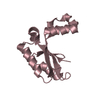
| ||||||||
| 4 | 
| ||||||||
| Unit cell |
|
- Components
Components
| #1: Protein |  Mass: 12964.396 Da / Num. of mol.: 4 / Fragment: UNP residues 45-157 Source method: isolated from a genetically manipulated source Source: (gene. exp.)   Mycobacterium tuberculosis (bacteria) / Strain: H37Rv / Gene: ftsX, MT3185, MTCY164.12c, Rv3101c / Production host: Mycobacterium tuberculosis (bacteria) / Strain: H37Rv / Gene: ftsX, MT3185, MTCY164.12c, Rv3101c / Production host:   Escherichia coli (E. coli) / References: UniProt: P9WG19 Escherichia coli (E. coli) / References: UniProt: P9WG19#2: Chemical | #3: Water | ChemComp-HOH / |  Water Water |
|---|
-Experimental details
-Experiment
| Experiment | Method:  X-RAY DIFFRACTION / Number of used crystals: 1 X-RAY DIFFRACTION / Number of used crystals: 1 |
|---|
- Sample preparation
Sample preparation
| Crystal | Density Matthews: 2.2 Å3/Da / Density % sol: 44.14 % |
|---|---|
Crystal grow | Temperature: 291 K / Method: vapor diffusion, hanging drop / pH: 8 Details: 25% PEG MME 2000, 150mM KBr, pH 8, VAPOR DIFFUSION, HANGING DROP, temperature 291K |
-Data collection
| Diffraction | Mean temperature: 100 K | |||||||||||||||||||||||||||||||||||||||||||||||||||||||||||||||||||||||||||||
|---|---|---|---|---|---|---|---|---|---|---|---|---|---|---|---|---|---|---|---|---|---|---|---|---|---|---|---|---|---|---|---|---|---|---|---|---|---|---|---|---|---|---|---|---|---|---|---|---|---|---|---|---|---|---|---|---|---|---|---|---|---|---|---|---|---|---|---|---|---|---|---|---|---|---|---|---|---|---|
| Diffraction source | Source:  SYNCHROTRON / Site: SYNCHROTRON / Site:  ALS ALS  / Beamline: 8.3.1 / Wavelength: 1.11 Å / Beamline: 8.3.1 / Wavelength: 1.11 Å | |||||||||||||||||||||||||||||||||||||||||||||||||||||||||||||||||||||||||||||
| Detector | Type: ADSC QUANTUM 315r / Detector: CCD / Date: Dec 6, 2012 | |||||||||||||||||||||||||||||||||||||||||||||||||||||||||||||||||||||||||||||
| Radiation | Monochromator: Double flat crystal, Si(111) / Protocol: SINGLE WAVELENGTH / Monochromatic (M) / Laue (L): M / Scattering type: x-ray | |||||||||||||||||||||||||||||||||||||||||||||||||||||||||||||||||||||||||||||
| Radiation wavelength | Wavelength : 1.11 Å / Relative weight: 1 : 1.11 Å / Relative weight: 1 | |||||||||||||||||||||||||||||||||||||||||||||||||||||||||||||||||||||||||||||
| Reflection | Resolution: 1.87→50 Å / Num. all: 38850 / Num. obs: 38783 / % possible obs: 99.5 % / Redundancy: 6.8 % / Biso Wilson estimate: 23.77 Å2 / Rmerge(I) obs: 0.111 / Χ2: 0.964 / Net I/σ(I): 8.7 | |||||||||||||||||||||||||||||||||||||||||||||||||||||||||||||||||||||||||||||
| Reflection shell |
|
- Processing
Processing
| Software |
| |||||||||||||||||||||||||||||||||||||||||||||||||||||||||||||||||||||||||||||||||||||||||||||||||||||||||
|---|---|---|---|---|---|---|---|---|---|---|---|---|---|---|---|---|---|---|---|---|---|---|---|---|---|---|---|---|---|---|---|---|---|---|---|---|---|---|---|---|---|---|---|---|---|---|---|---|---|---|---|---|---|---|---|---|---|---|---|---|---|---|---|---|---|---|---|---|---|---|---|---|---|---|---|---|---|---|---|---|---|---|---|---|---|---|---|---|---|---|---|---|---|---|---|---|---|---|---|---|---|---|---|---|---|---|
| Refinement | Method to determine structure : :  MOLECULAR REPLACEMENT / Resolution: 1.874→45.243 Å / Occupancy max: 1 / Occupancy min: 0.82 / SU ML: 0.21 / σ(F): 1.34 / Phase error: 23.16 / Stereochemistry target values: ML MOLECULAR REPLACEMENT / Resolution: 1.874→45.243 Å / Occupancy max: 1 / Occupancy min: 0.82 / SU ML: 0.21 / σ(F): 1.34 / Phase error: 23.16 / Stereochemistry target values: ML
| |||||||||||||||||||||||||||||||||||||||||||||||||||||||||||||||||||||||||||||||||||||||||||||||||||||||||
| Solvent computation | Shrinkage radii: 0.9 Å / VDW probe radii: 1.11 Å / Solvent model: FLAT BULK SOLVENT MODEL | |||||||||||||||||||||||||||||||||||||||||||||||||||||||||||||||||||||||||||||||||||||||||||||||||||||||||
| Displacement parameters | Biso max: 74.63 Å2 / Biso mean: 27.373 Å2 / Biso min: 4.37 Å2 | |||||||||||||||||||||||||||||||||||||||||||||||||||||||||||||||||||||||||||||||||||||||||||||||||||||||||
| Refinement step | Cycle: LAST / Resolution: 1.874→45.243 Å
| |||||||||||||||||||||||||||||||||||||||||||||||||||||||||||||||||||||||||||||||||||||||||||||||||||||||||
| Refine LS restraints |
| |||||||||||||||||||||||||||||||||||||||||||||||||||||||||||||||||||||||||||||||||||||||||||||||||||||||||
| LS refinement shell | Refine-ID: X-RAY DIFFRACTION / Total num. of bins used: 14
|
 Movie
Movie Controller
Controller



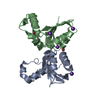




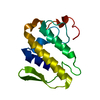
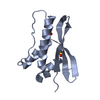

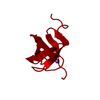


 PDBj
PDBj


